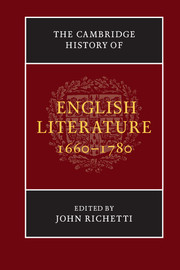Book contents
- Frontmatter
- Introduction
- PART I LITERARY PRODUCTION AND DISSEMINATION: CHANGING AUDIENCES AND EMERGING MEDIA
- PART II LITERARY GENRES: ADAPTATION AND REFORMATION
- PART III LITERATURE AND INTELLECTUAL LIFE: THE PRODUCTION AND TRANSMISSION OF CULTURE
- 14 History and literature 1660–1780
- 15 A preliminary discourse on philosophy and literature
- 16 Britain and European literature and thought
- 17 Religion and literature
- 18 Literary criticism and the rise of national literary history
- 19 Augustan England and British America
- PART IV LITERATURE AND SOCIAL AND INSTITUTIONAL CHANGE
- PART V LITERARY GENRES: TRANSFORMATION AND NEW FORMS OF EXPRESSIVENESS
- PART VI CONCLUSION
- Chronology
- Bibliographies
- Index
- References
17 - Religion and literature
from PART III - LITERATURE AND INTELLECTUAL LIFE: THE PRODUCTION AND TRANSMISSION OF CULTURE
Published online by Cambridge University Press: 28 March 2008
- Frontmatter
- Introduction
- PART I LITERARY PRODUCTION AND DISSEMINATION: CHANGING AUDIENCES AND EMERGING MEDIA
- PART II LITERARY GENRES: ADAPTATION AND REFORMATION
- PART III LITERATURE AND INTELLECTUAL LIFE: THE PRODUCTION AND TRANSMISSION OF CULTURE
- 14 History and literature 1660–1780
- 15 A preliminary discourse on philosophy and literature
- 16 Britain and European literature and thought
- 17 Religion and literature
- 18 Literary criticism and the rise of national literary history
- 19 Augustan England and British America
- PART IV LITERATURE AND SOCIAL AND INSTITUTIONAL CHANGE
- PART V LITERARY GENRES: TRANSFORMATION AND NEW FORMS OF EXPRESSIVENESS
- PART VI CONCLUSION
- Chronology
- Bibliographies
- Index
- References
Summary
The religious spectrum
It is now more widely recognised than it was a hundred years ago that seventeenth- and eighteenth-century English society and culture was essentially religious in its institutions, practices and beliefs, and that writing on religious subjects dominated the publishing market. Yet as literary readers in the early twenty-first century, we still confine our attention to a handful of explicitly religious works of the period, and we tend to downplay the religious aims and aspects of other works that we regard as predominantly literary or political or philosophical. Behind the major religious works that are still reedited and reissued today – notably Milton's Paradise Lost and Bunyan's Pilgrim's Progress – stretches a vast hinterland of works that went through multiple editions in the eighteenth century and often into the nineteenth, but that are now largely neglected except by specialists. This chapter provides a map for exploring this hinterland. But in order to understand the significance of particular works it is necessary first to consider three broad topics: the range of religious denominations and groups and the main political events that affected their relations with each other; the principal theological and philosophical issues that religious writers of different persuasions addressed; and the preferred kinds of religious writing and their functions.
- Type
- Chapter
- Information
- The Cambridge History of English Literature, 1660–1780 , pp. 445 - 470Publisher: Cambridge University PressPrint publication year: 2005
References
- 2
- Cited by

